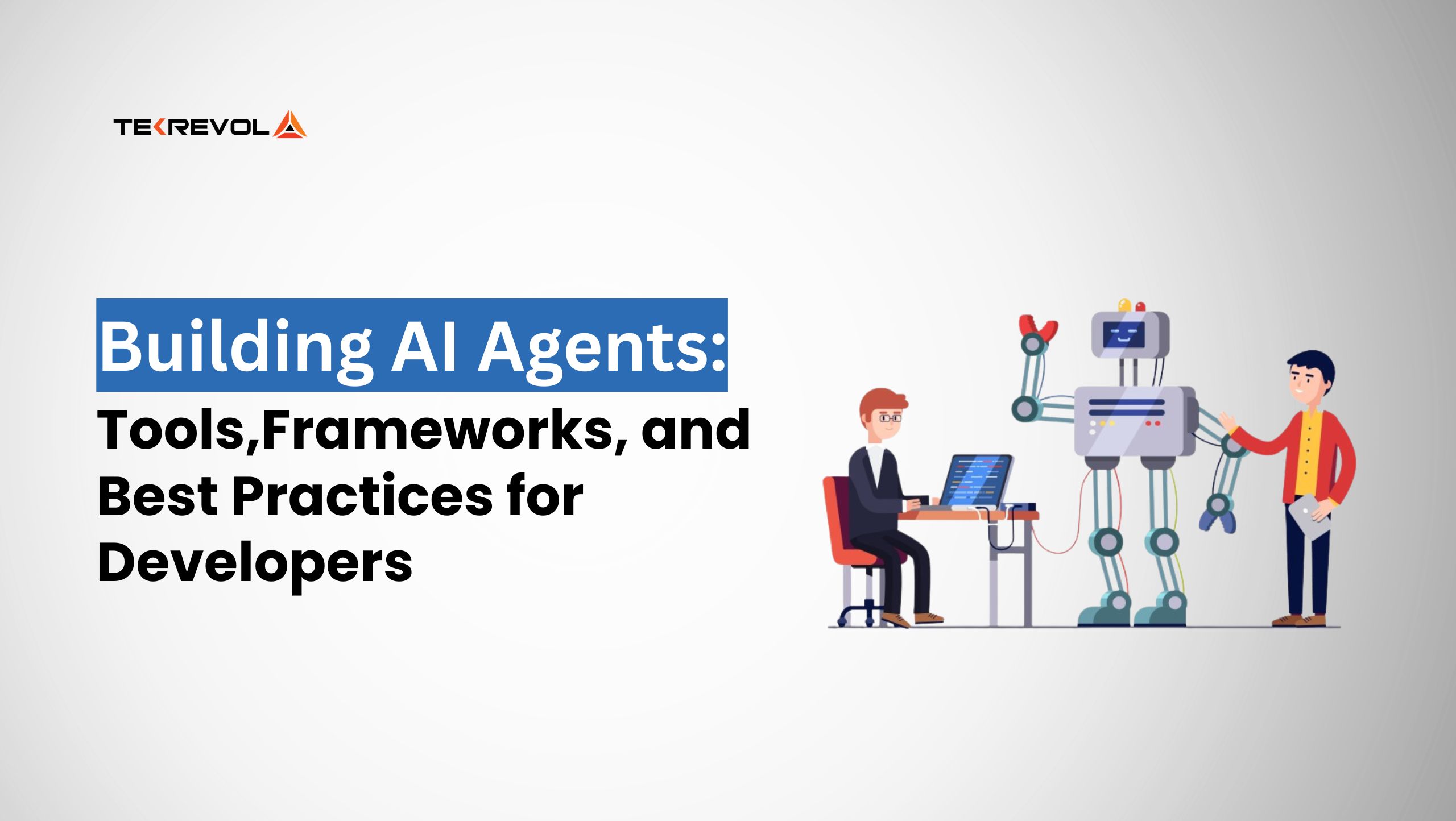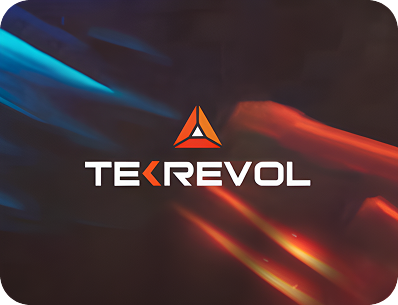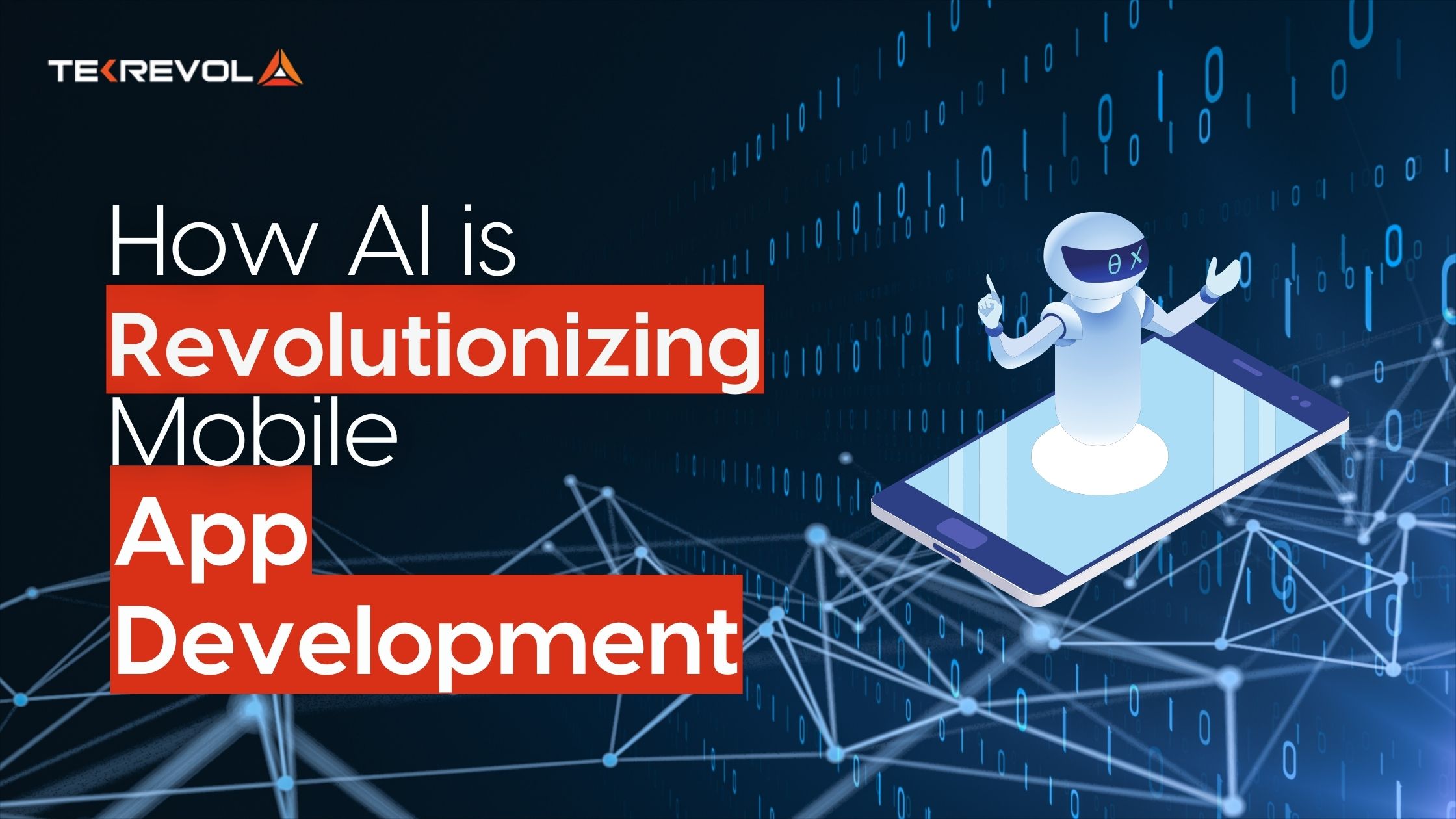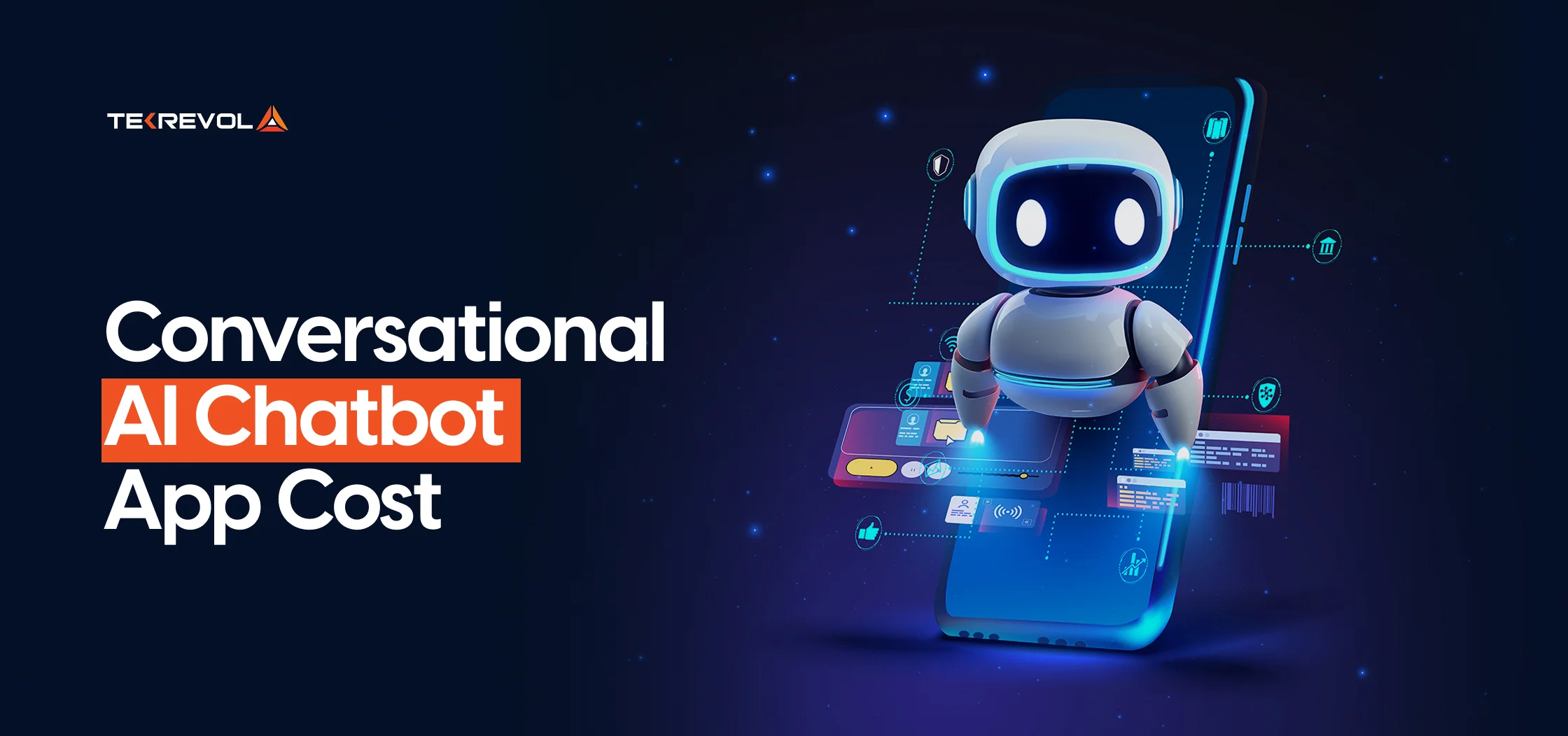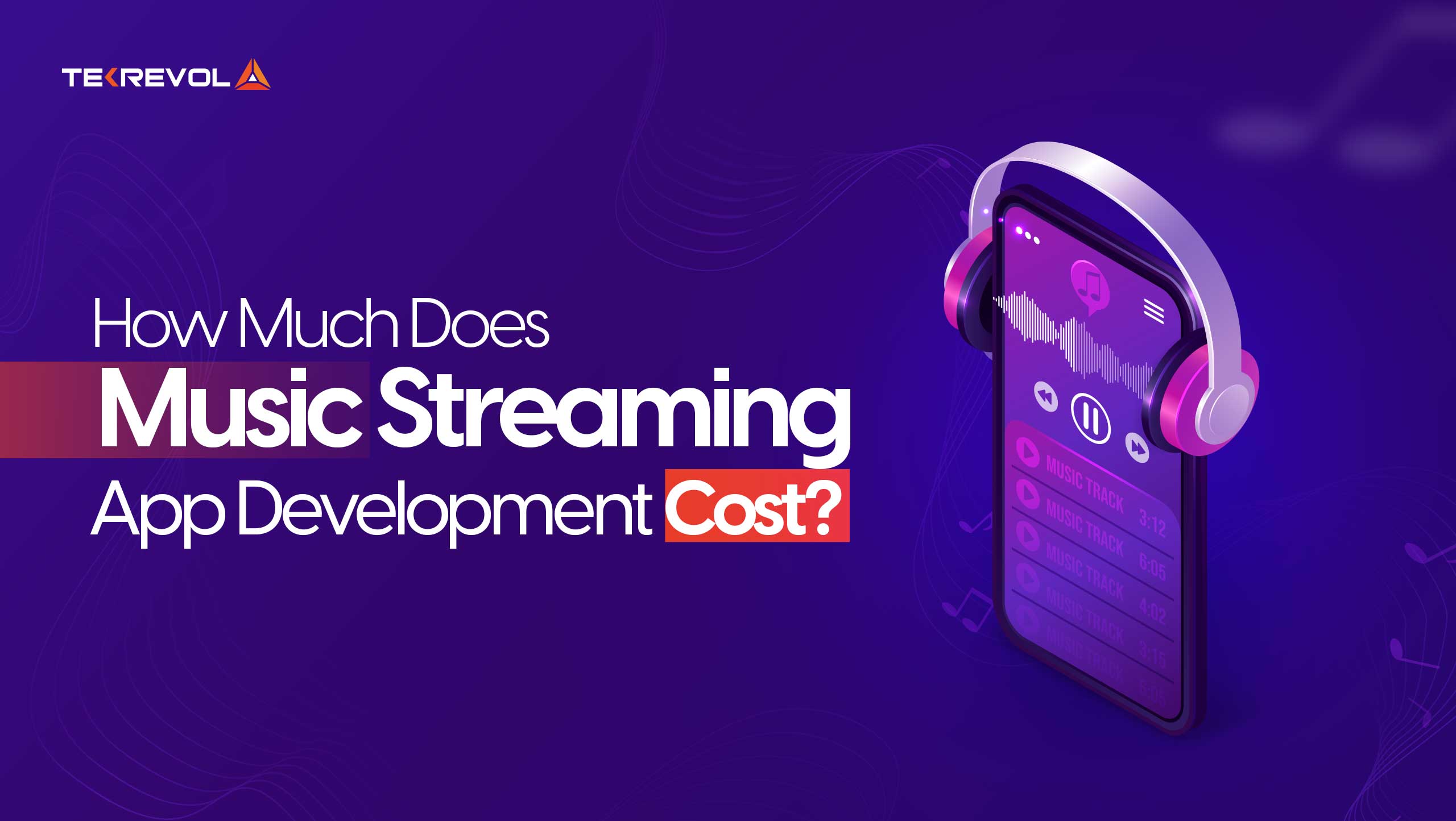Everyone’s talking about AI agents, but not enough people understand what they can bring to their business.
We hear the buzzwords: automation, intelligent systems, task delegation. But beyond the hype, most companies, and even many developers, struggle to grasp the real potential of AI agents.
These aren’t just fancy chatbots. We’re talking about autonomous systems that can analyze data, make decisions, take action, and even collaborate with other agents or humans, without constant supervision.
The problem? Most teams either overestimate what off-the-shelf tools can do or underestimate the planning, architecture, and integration required to make AI agents actually useful.
According to a 2024 Deloitte report, nearly 55% of enterprises experimenting with AI agents abandon the project within six months due to poor implementation or lack of clarity on use cases.
Don’t worry, we’ve penned down the essentials for building AI agents so you don’t have to figure it all out from scratch.
In this blog, we’ll walk you through the most reliable tools, the top-performing frameworks for AI agents, and the best practices to train an AI agent that leading developers are using to build intelligent, goal-driven AI agents.
So, let’s get started!
What Is an AI Agent?
An AI agent is like a smart digital assistant that acts on your behalf. It utilizes artificial intelligence to comprehend its surroundings, make informed decisions, and execute tasks, often without requiring constant human input.
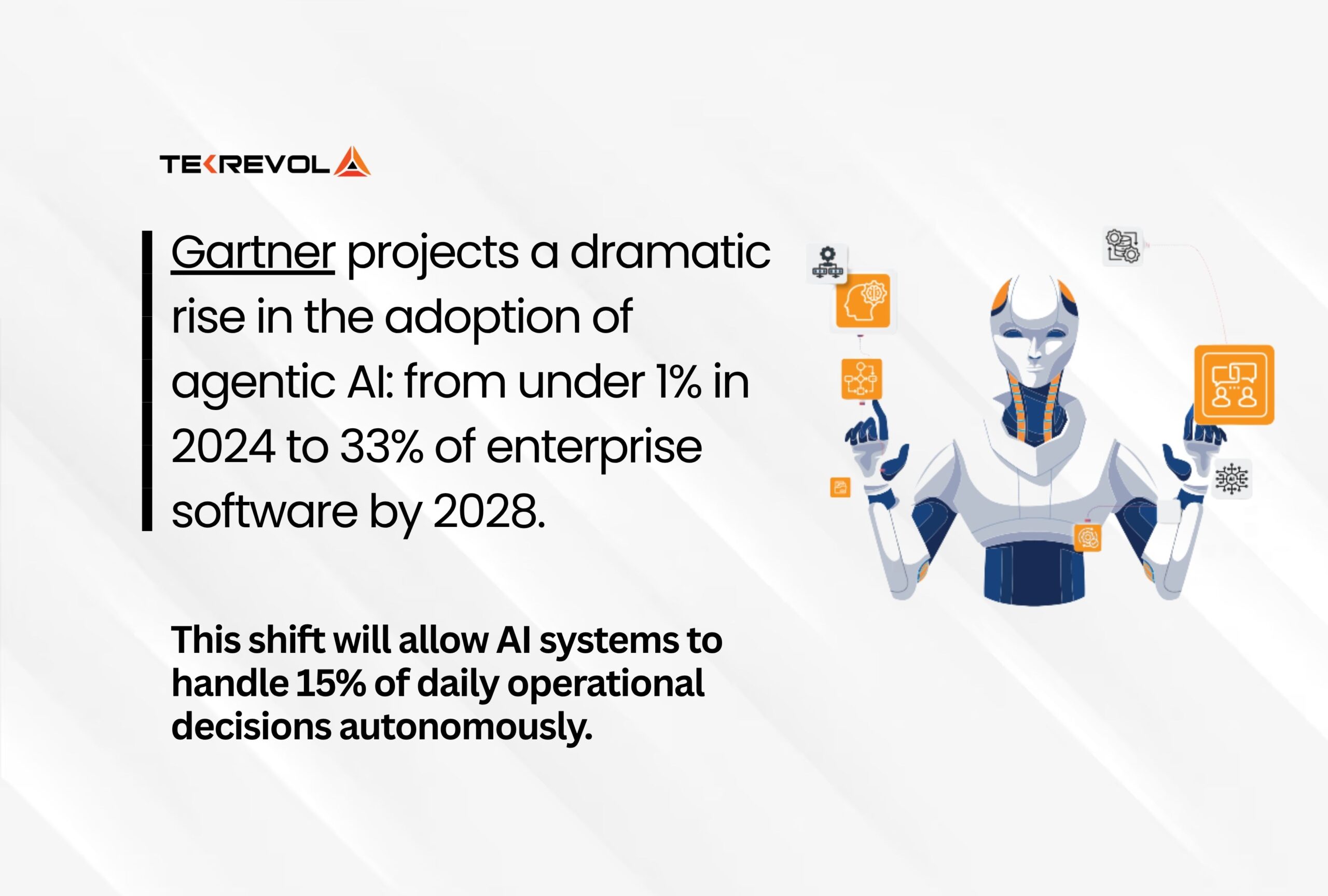
Key Features:
- Autonomy: Can operate without ongoing human oversight
- Goal-Directed: Works based on specified tasks or goals
- Contextual-Aware: Has short- or long-term memory
- Action-Available: Can communicate with tools, APIs, or other agents
- Reasoning: Employs logic or LLM-based reasoning to determine next steps
Whether assisting people with email handling or driving logistics in the background, AI agents are becoming critical digital workforce constituents.
How AI Agents Are Shaping the Future of Business Operations
AI agents are smart computer programs that can autonomously perform actions, make choices, and communicate with other systems. They’re being widely implemented across departments such as customer support, finance, HR, and marketing to enhance efficiency and decision-making.
Let’s examine in more detail how AI agents benefit Human Resources functions.
Major Use Cases of AI Agents for HR:
- Resume Screening: It means analyzing, scoring, and shortlisting applications for jobs according to given parameters automatically.
- Interview Scheduling: Checking schedules and sending invites to interviewers and interviewees, all done by machine without a human touch.
- Employee Onboarding: Taking new employees through the onboarding process. Distributing documents/Form collection/FAQs.
- HR Helpdesk Automation: Employing the automatic answering of employee questions regarding leave, benefits, and other internal resources, via a standard mechanism, 24/7.
- Training Coordination: Recommend applicable courses and monitor employee progress through learning management systems.
Businesses using AI agents report up to a 30% increase in workflow efficiency.
TekRevol helps you design scalable AI agents that drive real productivity gains.
Build Your AI Agent Now!Real-World Applications of Custom AI Agents
Intelligent Customer Support
AI agents process FAQs, complete simple requests, and responsibly forward intricate questions to human reps, lessening response time and administrative load. Businesses using AI chatbots have seen up to a 30% drop in customer support costs (IBM, 2024).
Virtual Medical Assistants
In medicine, AI agents can aid with initial diagnosis based on symptom input, track vitals after surgery, and assist with managing medication regimens, improving patient outcomes. By 2025, AI tools in healthcare are expected to help reduce clinical errors by 30% and cut administrative costs.
Bespoke E-Commerce Recommendations
AI agents analyze user behavior and purchasing habits to recommend personalized products, thereby enhancing user engagement and increasing conversion rates. Personalized product recommendations powered by AI can increase conversion rates by up to 49%.
Smart Supply Chain Management
Ranging from demand curve forecasting to inventory level optimization, AI agents make supply chains smarter by providing real-time intelligence and automated inventory management.
Telecommunications Performance Optimization
Telecommunications firms leverage AI agents to predict outages, manage network loads, and expedite issue resolution, guaranteeing faultless connectivity amid high-traffic conditions.
According to a Deloitte report, AI‑powered predictive maintenance can reduce telecom maintenance costs by up to 25% and increase asset utilization by up to 20%, delivering significant savings and operational efficiency.
Best Frameworks For AI Agent Development (2025 Edition)
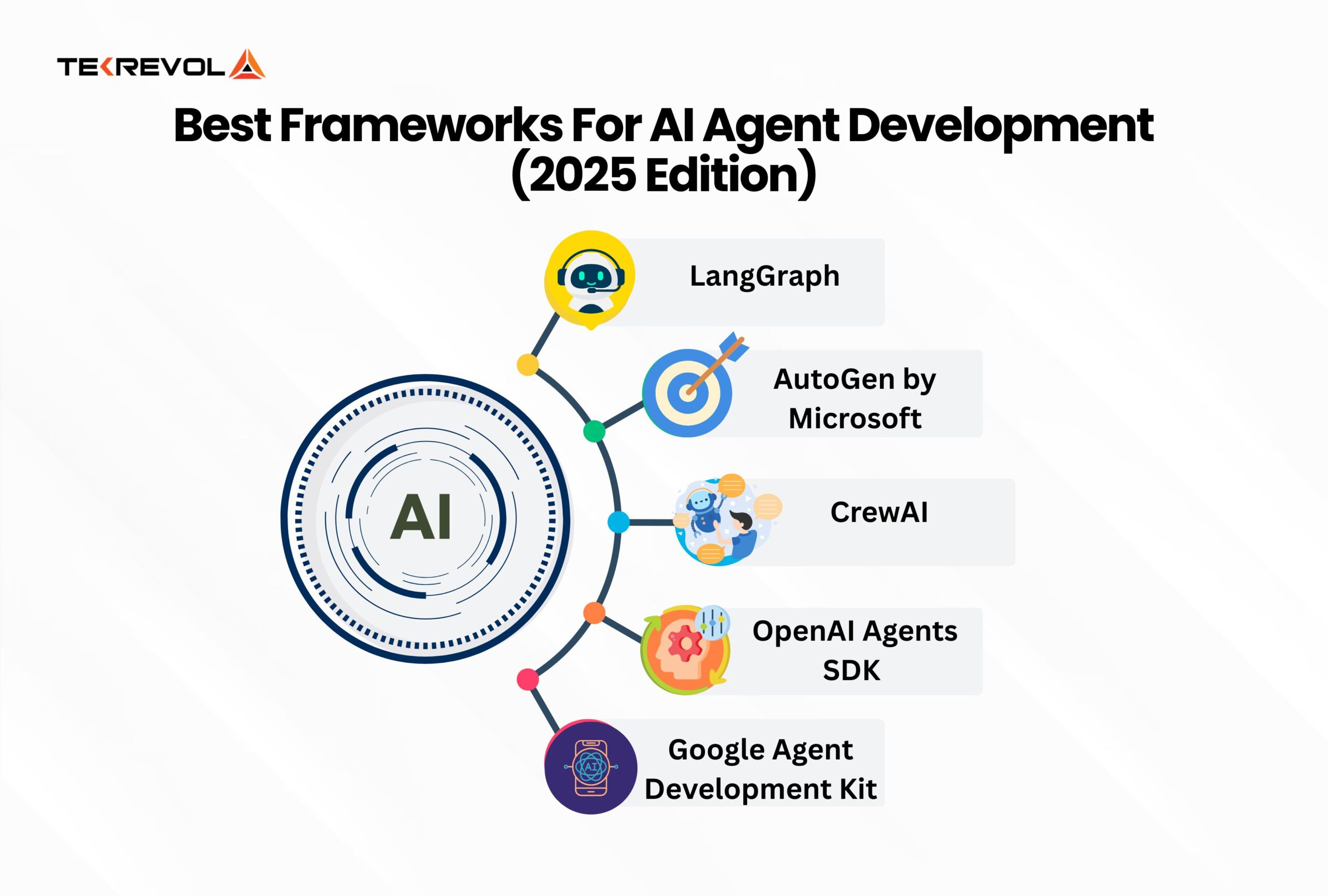
Although pre-trained enterprise AI agents are an excellent choice for big organizations, developing customized agents provides more flexibility, control, and alignment with individual needs for businesses.
Whether you’re a developer or a non-technical team, there is a maturing ecosystem of tools supporting both no-code and code development of agents.
Below is a list of the major frameworks for AI agent development that are leading the charge in 2025:
1. LangGraph
LangGraph is part of the LangChain suite and is designed to build stateful, streaming-enabled AI agents with multi-agent orchestration support.
Key Features:
- Stateful Interactions: Preserves context over lengthy conversations.
- Multi-Agent Support: Single, multi-agent, hierarchical, and sequential workflows.
- LangSmith Integration: For observability, monitoring, and performance tracking.
- Human-in-the-loop: Human approval and intervention steps integrated.
- Streaming Responses: Real-time communication and enhanced user UX.
- Long-term Memory: Retains context across sessions.
Enterprise Adoption: Implemented in Klarna to decrease customer support resolution time by 80%.
2. AutoGen by Microsoft
A sophisticated platform for developing multi-agent dialogue with an event-driven architecture. AutoGen is specifically optimized for collaborative problem-solving and enterprise processes.
Key Features:
- Multi-Agent Collaboration: Coordinates multiple agents to complete intricate tasks.
- Event-Driven Architecture: Supports timely agent communication.
- Extensive Documentation: Perfect for beginners and experts alike.
- LLM Integration: Supports different large language models.
- Scalable Design: Designed for intricate enterprise-level workflows.
- Academic Usage: Used in universities and training schools.
Real-World Use: Utilized by Novo Nordisk to drive data science processes.
3. CrewAI
Released in 2024, CrewAI is centered on cooperative role-based agents with easy configuration, ideal for customer support, marketing, and automation applications.
Key Features:
- Role-Based Agents: Allocate distinct functions to every agent.
- Bare Minimum Setup: Simple to deploy with a bare minimum code requirement.
- No Dependency on LangChain: Lightweight and standalone.
- Team-based Workflows: Built for agents to collaborate.
- Fast Adoption: Most popular among teams for rapid automation solutions.
Use Case: Commonly utilized in marketing automation and customer service configurations.
4. OpenAI Agents SDK (Released March 2025)
A light Python SDK that makes it easy for developers to create and run safe, traceable, multi-agent workloads with extensive LLM support.
Key Features:
- Small footprint: Built for rapid integration with minimal code overhead.
- Provider-agnostic: Integrated with 100+ LLMs outside of OpenAI models.
- Tracing in detail: Integrated tools for monitoring, debugging, and analysis.
- Guardrails built-in: Ensures agent safety and behavior management.
- Low learning curve: Ideal for Python programmers new to agents.
5. Google Agent Development Kit (ADK)
Google’s ADK introduces modular, composable agent development into the Gemini and Vertex AI platform, thus making it perfect for organizations already on Google Cloud.
Why it’s handy:
- Native Google integration: Seamlessly integrates with Gemini and Vertex AI services.
- Modular design: Combine and rearrange parts to create adaptive agents.
- Hierarchical agent support: Handle intricate dependencies among agents.
- Custom tool-building: Enhance functionality for targeted business applications.
- Low-code efficiency: Create functional agents in fewer than 100 lines of code.
Quick Comparison Table
| Framework/Tool | Best For | Key Strengths | GitHub Stars (2025) |
| LangGraph | Stateful agents & enterprise apps | Streaming, memory, LangSmith integration | 14,000+ |
| AutoGen (Microsoft) | Multi-agent collaboration | Event-driven design, LLM-agnostic | 45,000+ |
| CrewAI | Quick builds & marketing automation | Role-based agents, minimal dependencies | 32,000+ |
| OpenAI Agents SDK | Lightweight Python workflows | Provider-agnostic, guardrails, tracing | 11,000+ |
Best No-Code & Open-Source AI Agent Tools for Rapid Development
If your team does not have deep AI programming techniques or just needs to develop quickly, these no-code and open-source AI agent platforms have robust, versatile, and scalable solutions. From drag-and-drop to completely editable frameworks, here are the top no-code AI tools you can utilize today.
1. Dify – Visual AI Agent Builder for Rapid Prototyping
Perfect for: Non-technical teams, startups, and corporations
GitHub Stars: 93,000+
Dify is a low-code platform that makes AI agent creation easy by having a user-friendly interface and pre-existing strategies.
Major Features:
- Visual Builder: Drag-and-drop development of the agent.
- Multi-Model Support: Supports hundreds of LLMs.
- Prebuilt Strategies: RAG, ReAct, Function Calling.
- Enterprise Tools: Financial analysis, document generation.
- Integrated Vector Search: Scalable search using TiDB.
- Fast Prototyping: Great for rapid MVPs and POCs.
2. AutoGPT – Modular Think Agent for You
Suitable for: Automation-oriented workflows, research labs, technical teams
Developed with: OpenAI GPT models
AutoGPT revolutionized the independent AI agent category by enabling agents to plan and perform tasks on their own.
Main Features:
- Goal Decomposition: Splits large tasks into sub-tasks.
- Web Access: Searches and interacts with web data.
- Persistent Memory: Remembers knowledge between sessions.
- API Integration: Integrates with numerous external tools.
- Open Source: Highly customizable.
Pricing: Free (excluding OpenAI API expenses).
3. n8n – Open-Source Workflow Automation with AI Integration
Best for: Automating business processes, marketing, and non-coders
n8n simplifies the creation of complex AI workflows without code through its drag-and-drop interface.
Key Features:
- No-Code Workflows: Visual automation builder.
- AI-Friendly: Integrated with GPT, Claude, and others.
- Rich Integrations: Hundreds of apps and service connectors.
- Self-Hosting: Kept on-premise if required.
- Debugging Tools: Visual testing and monitoring.
4. Rasa – Enterprise-Grade Conversational AI Framework
Perfect for: Custom chatbot building, enterprises, and regulated sectors
Rasa enables teams to create highly customizable AI conversation agents, with no vendor lock-in and complete control.
Key Features:
- Complete Customization: Customize everything to your requirements.
- CALM Architecture: Isolates intent and logic layers.
- Private Deployment: On-premises and secure installations.
- Enterprise Support: Support from professionals is available.
- Multilingual: Supports multiple languages.
- Community Driven: Robust open-source community.
5. BotPress – Hybrid Chatbot Builder with Visual + Code Interface
Ideal for: Support bots, sales assistants, real-time chat systems
BotPress provides a balance between no-code design and developer-level control, with built-in analytics and integrations.
Key Features:
- Visual Flow Builder: Easy drag-and-drop conversation design
- Custom Code Hooks: Extend with JavaScript or TypeScript.
- Analytics Dashboard: Track user behavior and bot performance.
- Multi-Platform: Deploy across web, Messenger, WhatsApp, and more.
- Modular & Open Source: Extend and self-host freely.
Top Pre-Built Enterprise AI Agents for Large-Scale Deployment
Enterprise-level AI agents are becoming indispensable tools for businesses seeking to automate processes. The following platforms are the strongest production-grade AI agents, each specialized for enterprise-specific applications, ranging from software development to CRM automation and document workflow.
1. Devin AI by Cognition Labs
Purpose: Autonomous Software Development Agent
Best For: Dev operations, engineering teams, legacy code modernization
Devin AI is the industry’s first AI software engineer, able to handle entire development lifecycles independently. Built by elite competitive programmers, Devin applies reinforcement learning and large language models within a safe, sandboxed environment.
Why It’s Noteworthy:
- Nubank and other companies have realized 12x improvements in efficiency and 20x cost savings.
- Shines in legacy code refactoring and bug fixing at scale.
- Writes, tests, and deploys applications independently.
- Collaboration tools that work in real-time with human developers.
- Integrates with VSCode and dev environments.
- Begins at $20/month for individuals, with enterprise options.
2. Agentforce by Salesforce
Purpose: Smart CRM Automation
Best For: Sales, service, marketing, and commerce teams
Agentforce takes Salesforce’s market-leading CRM platform into the world of AI. These pre-built agents leverage generative AI and Salesforce Data Cloud to automate customer-facing workflows with high accuracy and contextual understanding.
Why It’s Noteworthy:
- Trusted by brands such as The Adecco Group and OpenTable.
- Applies AI-native automation to existing Salesforce workflows.
- Pre-configured AI agents for CRM activities such as lead management and customer service.
- Low-code development of new agents.
- Runs on web, mobile, and channels such as Slack.
- Leverages Salesforce’s single customer view.
3. Microsoft Copilot Studio
Purpose: AI Assistants for the Microsoft 365 Ecosystem
Best For: Teams in business working in Excel, Word, Outlook, and Teams
Copilot Studio enables teams to create AI assistants that are natively integrated with Microsoft 365. With a low-code model and access to Azure AI models, businesses automate daily workflows in a short period and at scale.
Why It’s Noteworthy:
- Customers such as ICG saved $500K and increased margins by 20%.
- Integrates seamlessly with tools teams already use on a daily basis.
- Native integration with Microsoft 365 applications.
- Drag-and-drop capability for non-technical developers.
- Multi-agent orchestration for more sophisticated use cases.
- Utilizes more than 1,800 Azure Foundry models.
4. IBM Watsonx Assistant
Purpose: Secure Conversational AI for Regulated Industries
Best For: Banking, healthcare, and public sector enterprises
Rooted in IBM’s extensive AI research heritage, Watsonx Assistant is an enterprise-grade conversational agent platform with a focus on security and compliance. It is especially useful in industries needing strict standards for handling data.
Why It’s Noteworthy:
- Established enterprise trust, particularly in highly regulated industries.
- Natural language understanding paired with business-grade integration.
- No-code dialog builder to quickly build chatbots.
- Multi-channel support across digital channels.
- Enterprise-level security aligned to industry compliance standards.
- Watsonx LLMs elevate conversation quality with generative AI.
- Flexible pricing at scale with IBM Cloud and usage-based.
Over 40% of enterprises are adopting
AI agents to scale operations We specialize in building custom AI agents that align with your business goals!
Book A FREE Consultation now!Tips to Choose the Right Tools and Platforms for AI Agent Development
Selecting the optimal platform for developing AI agents is not only a matter of features; it’s identifying the tool that best fits your tech abilities, business objectives, and use case. Follow these steps for building AI agents with the appropriate selection:
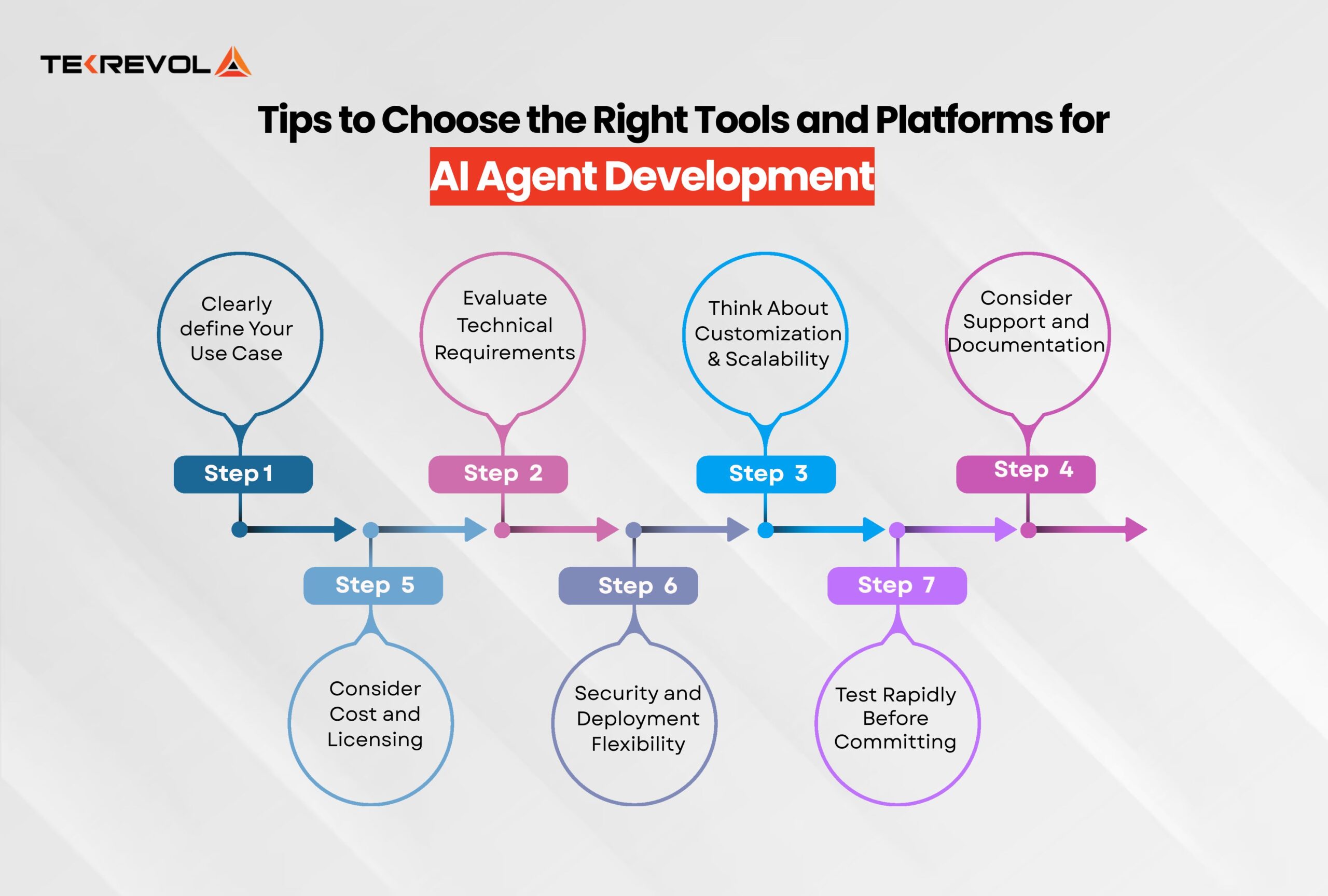
1. Clearly define Your Use Case
Prior to considering tools, pose the questions:
- What do you need the AI agent to accomplish?
- Is it customer-facing (i.e., chatbots) or backend (i.e., data automation)?
- Will it have to integrate with external APIs or involve heavy reasoning?
2. Evaluate Technical Requirements
Certain platforms are no-code and user-friendly (such as Dify or n8n), but others (such as AutoGPT or Rasa) require more development knowledge. Think about:
- Your developers’ coding skills
- Your deployment setup (cloud, on-premises, or hybrid)
- Integration requirements with internal systems
| Tool Type | Best For | Technical Skills Needed |
| No-Code (e.g., Dify, n8n) | Quick prototypes, non-tech teams | Low |
| Open-Source (e.g., AutoGPT, Rasa) | Full control, advanced customization | Medium to High |
3. Think About Customization & Scalability
If your project can increase in complexity, opt for platforms that enable:
- Custom workflows
- Multi-agent configurations
- Memory and reasoning support (such as RAG or ReAct)
- API hooks for modular growth
4. Consider Support and Documentation
Excellent community support, regular updates, and good documentation are essential, particularly for open-source software like Rasa or BotPress. Look at:
- GitHub activity
- Forum support
- Official tutorials and SDKs
5. Consider Cost and Licensing
Some of them are free but take API credits (such as OpenAI), and some will charge for enterprise-grade features.
| Platform | Cost Structure |
| AutoGPT | Free to use, but OpenAI API charges apply |
| Dify | Open-source, hosted plan available |
| Rasa | Free; paid enterprise support |
| BotPress | Open-source with pro tier options |
6. Security and Deployment Flexibility
When you’re developing AI agents for heavily regulated sectors such as healthcare, finance, or government, security is not a choice but a requirement. You require platforms that provide:
- On-premises deployment to be in total command of data
- Role-based access control (RBAC)
- Audit trails and data encryption
- Regulatory compliance like HIPAA, GDPR, or SOC2
Rasa and BotPress are excellent options here, particularly for businesses that can’t afford to open data to third-party APIs. They allow you to host it all yourself, with the flexibility to control security end-to-end.
7. Test Rapidly Before Committing
Don’t dive into a full-scale buildout before experimenting. Most platforms today provide:
- Low-code visual builders
- Prebuilt templates or agents
- Sandbox environments for playing around
- Live debugging and interaction tools
Use these to rapidly test your AI agent’s fundamental functionality. Begin with a restricted use case (such as automating an FAQ or internal report) and see how the platform handles reasoning, API calls, and memory.
The AI agent market is projected to reach $22.1 billion by 2026
Partner with TekRevol to build intelligent, future-ready AI agents that scale with your business.
Start Your AI Agent Project!How to Train an AI Agent for Real-World Tasks? Step-By-Step Guide
Creating AI agents capable of more than basic chat exchange means having a good methodology for training, memory management, orchestration, and code organization. Here’s how developers can code smarter, more dependable agents that actually complete tasks.
1. Prompt Engineering: The Key to Agent Behavior
Prompt engineering is still one of the most influential tools, even before getting deep into heavy training. This means creating clear, directive prompts that lead large language models (LLMs) well.
- Few-shot prompting provides context to models by giving examples of what tasks should be done.
- Prompt chaining enables developers to divide complex tasks into several steps, with each step building on the next, perfect for multi-step processes.
- It’s a good idea to include validation prompts or self-checks, too, so agents can check their own work before taking action upon it.
Why it matters: Flawed prompts = unpredictable outputs. Properly designed prompts set the stage for stable, predictable agent responses.
2. Fine-Tuning & Reinforcement Learning: Domain-Specific Training
Following prompt engineering, more nuanced tuning usually comes by way of fine-tuning or reinforcement learning (RL) based on your application.
- Fine-tuning is best if you want the agent to communicate in the language of your domain, such as legal, health, or finance. You further train the model on a handpicked dataset to mold its responses.
- Reinforcement learning assists agents in learning from consequences. If you wish an AI agent to make optimal decisions or actions (such as suggesting inventory levels), RL rewards the agent for good behavior over time.
Example: Apply supervised fine-tuning to support chatbots to get familiar with product-specific vocabulary. Apply RL to train a supply chain agent to choose optimal shipping routes within budget limitations.
3. Memory and Retrieval Systems: Constructing Long-Term Intelligence
AI agents are not merely about responding; they must remember, recall, and refer to information dynamically.
- Employ vector databases or key-value stores to provide agents with a long-term memory. This is necessary for storing session context, user preferences, or interaction history.
- Apply Retrieval-Augmented Generation (RAG) to enable agents to draw real-time information from massive document stores, knowledge bases, or even internal wikis.
Example: An HR assistant agent can recall an employee’s previous question regarding benefits and tailor their subsequent response without beginning anew.
4. Multi-Agent Orchestration: Constructing Composite Task Pipelines
Advanced use cases aren’t about a single agent doing it all; it’s about expert agents collaborating harmoniously.
- Create an orchestrator agent that will schedule tasks and hand them off to sub-agents.
- Trends in this category, such as routing, parallelization, and task-based prompting, assist in dividing big objectives (such as making a report) into smaller, achievable components.
Use Case: A business analytics aide can have one agent to collect sales information, another to create insights, and a third to present the final report.
5. Tools and Frameworks: Accelerating Development
Contemporary agent platforms conserve time and diminish complexity:
- LangChain, AutoGen, and CrewAI provide SDKs and blueprints for constructing modular, multi-agent systems.
- These platforms enable prompt management, memory handling, tool invocation, and error control out of the box.
- Always include manual overrides and safety checks to avoid unwanted behavior, particularly in agents with autonomy.
How to Build Smarter AI Agents: Best Practices
Building smart AI agents is not about generating a couple of prompts; it’s about developing systems that think, act, and learn within real workflows. The following are the major best practices that successful AI agent development follows:
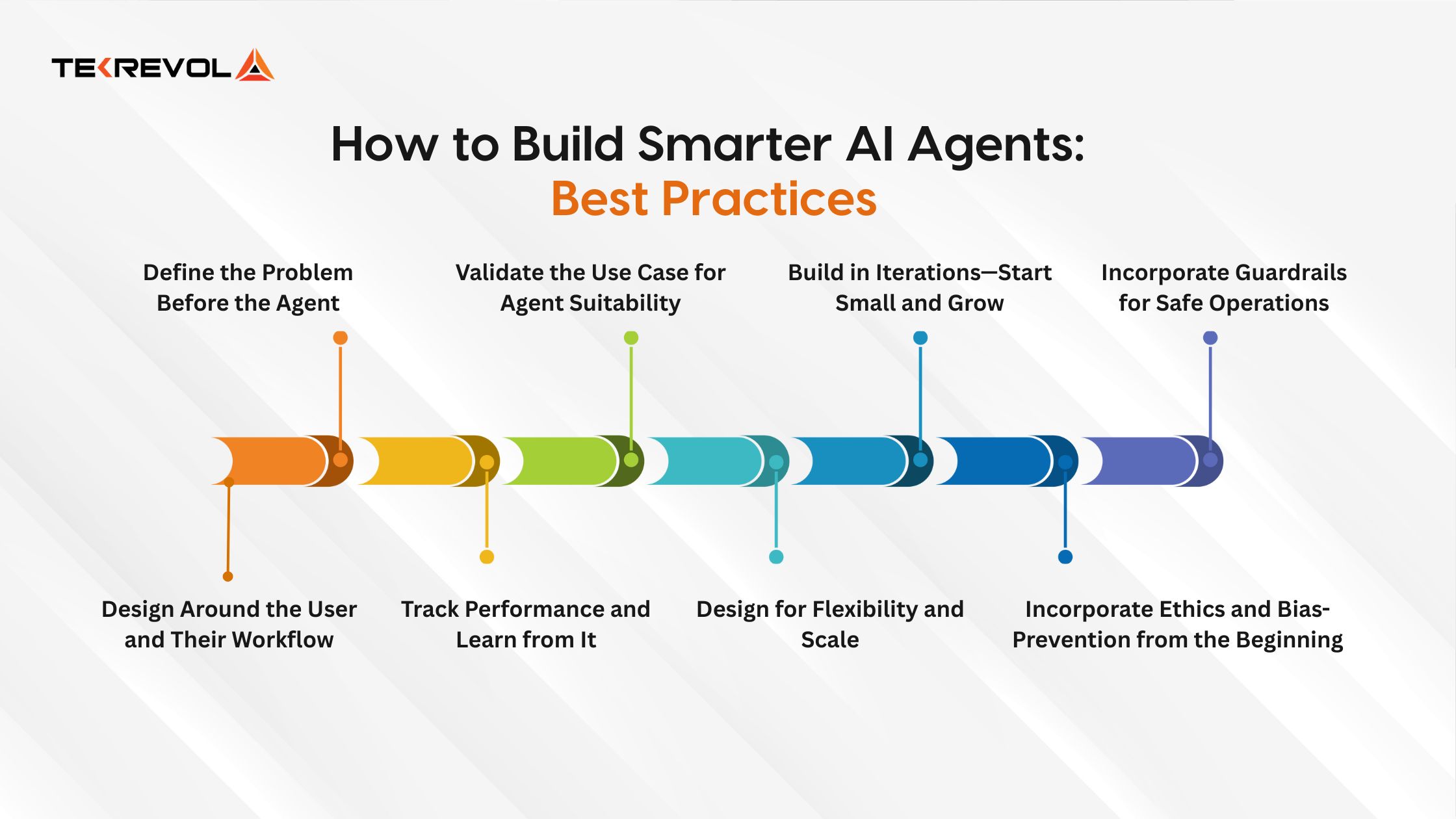
Before you start building your AI app, check out our in-depth blog: How to Build an AI App? Features, Trends, Development & Cost
1. Define the Problem Before the Agent
Not all tasks require an AI agent. Begin by defining your goal clearly:
- What is the agent intended to do?
- Is the task dynamic and sophisticated enough to need autonomy?
- How will success be measured—speed, accuracy, user satisfaction?
If the task is simple and predictable (e.g., summarizing text), direct calls to an LLM may suffice. Use agents when you’re dealing with multi-step logic, dynamic decisions, or unstructured data.
2. Validate the Use Case for Agent Suitability
Before building, make sure the problem is right for agent-based automation. Ask:
- Are there frequent, complex decisions involved?
- Are static rule-based systems hard to scale or maintain?
- Is input predominantly unstructured (e-mails, documents, user submissions)?
If so, the use case is a good candidate for agent-driven automation. Otherwise, look into simpler automation paradigms.
3. Build in Iterations—Start Small and Grow
Writing AI agents is not a single go. Start with a minimal viable agent that addresses a small but specific slice of the problem.
- Employ techniques such as prompt chaining to decompose tasks into rational steps.
- Test each function or utility the agent employs.
- Heed Anthropic’s counsel: keep it simple, make it complicated only when needed.
- Iterative development minimizes failure risk and allows easier debugging or pivoting.
4. Incorporate Guardrails for Safe Operations
AI agents may deviate from the script if not well-controlled. Guardrails need to be integrated into all layers:
- Input validation: Filter out troublesome prompts or unauthorized tasks.
- Output constraints: Place limits to avoid hallucination or unsafe behavior.
- Tool usage limits: Limit which external APIs or databases agents interact with.
- Fallback mechanisms: Allow users to intervene or take control of the agent when necessary.
5. Design Around the User and Their Workflow
Your AI agent needs to be useful, not perplexing. Design the system around actual workflows:
- Employ conversational UI or simple dashboards.
- Provide precise prompts and directions.
- Always permit human override or guidance where appropriate.
The more pleasant the experience for the end-user, the more effective the agent will prove in reality.
6. Track Performance and Learn from It
Measuring both quantitative and qualitative performance is important:
- Metrics to track: task success rate, response time, fallback frequency, etc.
- User feedback: What’s working? What’s frustrating?
Use the data to iterate, refine prompts, and tune models or memory systems.
7. Design for Flexibility and Scale
As your use case expands, your agent must also change:
- Have a modular design so parts (such as LLMs or tools) can be replaced or upgraded with ease.
- Watch API usage and expenditures to regulate scale.
- Put data security and privacy first, particularly if dealing with sensitive information.
Early planning for scale avoids huge technical debt down the line.
8. Incorporate Ethics and Bias-Prevention from the Beginning
Trust is paramount when rolling out AI:
- Adhere to compliance guidelines such as GDPR in using data.
- Train on varied sets of data to minimize nasty biases.
- Include content filters or layers of moderation where appropriate.
Responsible agent creation is not only best practice, but critical to actual-world adoption.
AI agent adoption is expected to grow 5x in the next two years.
We future-proof your business by building AI agents that learn, adapt, and evolve with your goals.
Schedule A FREE Consultation now!The Future of AI Agents: What Developers Must Know to Stay Ahead
The landscape of AI agents is changing quickly. In 2026, what we work with today could be a relic of the past, replaced by more intelligent, more autonomous, and more collaborative AI systems.
These are the top three trends defining the future of AI agents, and why you need to begin planning now.
1. Multi-Agent Collaboration Will Become the New Standard
AI agents will no longer operate independently. Next-gen systems will use several agents acting concurrently, resolving issues together, quite possibly without humans getting involved.
Consider Salesforce Agentforce, a real-world example: one agent identifies suspect transactions, while another halts payments, all on their own, all simultaneously. These are not hypothetical use cases; they’re already implemented in business settings.
What developers should concentrate on:
- Developing agent communication protocols
- Creating modular agents that can be easily inserted into larger systems
- Mastering orchestration and agent-to-agent task delegation
More than 75% of all enterprises will have multi-agent systems deployed by 2026, double the number today.
2. Dynamic Agents Will Need On-the-Fly Learning Abilities
Static, pre-trained agents are a dying breed. Future AI agents will learn on the fly with the help of tools such as Google Gemini 2.0’s Flash Thinking Mode and be able to adjust to new situations immediately without needing retraining.
Imagine building an AI customer support agent that can understand a newly launched CRM interface mid-conversation and use it effectively. That’s the future we’re heading toward.
What developers should focus on:
- Building contextual memory into agent architecture
- Designing agents that can learn from user interactions in real time
- Reducing dependency on model retraining cycles
Why it matters: Dynamic agents in industries such as logistics or fintech can lower operational costs by as much as 35% and decrease onboarding time by half.
3. Human-AI Collaboration Will Recast Workflows
AI isn’t taking the place of developers; it’s becoming their strategic partner.
More than 93% of workers are using AI tools to automate mundane tasks, releasing substantial time for innovation and strategic thinking.
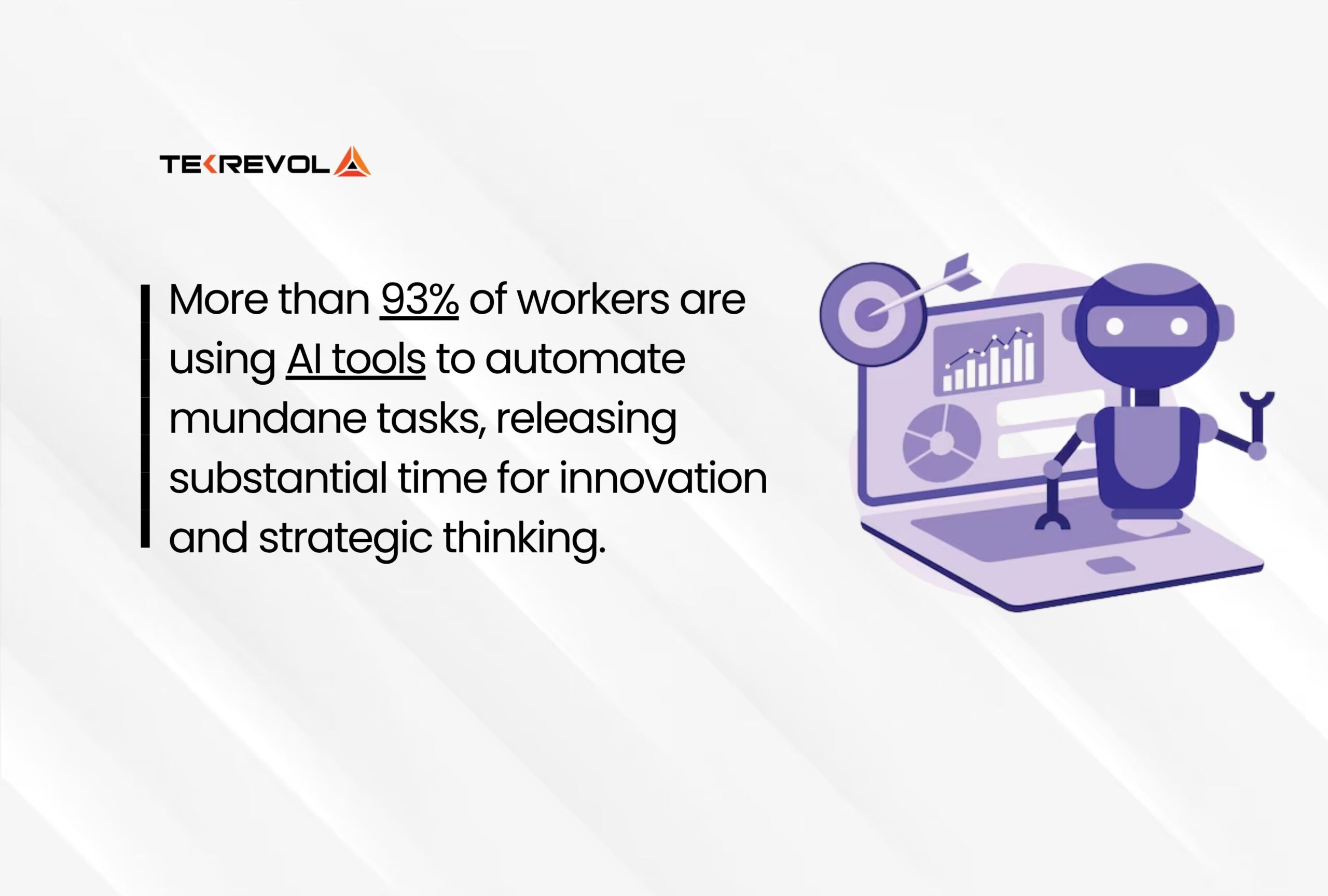
In the not-too-distant future, AI agents will be co-creators, assisting in idea-generating designs, suggesting code, or providing optimization suggestions in real time. View them more as creative collaborators than assistants.
What developers need to prioritize:
- Creating AI-human collaboration interfaces that are simple and easy to use
- Creating feedback cycles where agents can learn from user decisions
- Prioritizing explainability and transparency in AI recommendations
Launch Your Custom AI Agent with TekRevol
Developing an AI agent may seem techy, but it doesn’t have to be daunting. At TekRevol, we simplify the process, make it collaborative, and center it on tangible outcomes.
Our experts in AI are here to help you along the way, from pinpointing the optimal use case to deploying a fully working and stable agent. We don’t develop technology; we craft clever solutions that get actual work done and help your business thrive in the long term.
As a leading AI Agent Development company, we’ve a successful history of implementing scalable AI systems in every industry. We’re ready to assist you in creating wiser, faster, and more confidently. Whether you’re starting from scratch or scaling an existing solution, we tailor every aspect of development to fit your needs.
Check out our blog, “AI-Powered App Development at TekRevol,” to learn how we build intelligent apps that make an impact.
Launch Intelligent Conversations with
Tekrevol’s AI Solutions Speed and personalization aren’t optional anymore. Partner with an expert team that builds AI chatbots and agents that actually work.
Book a Strategy Call Today
